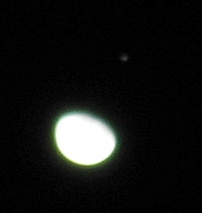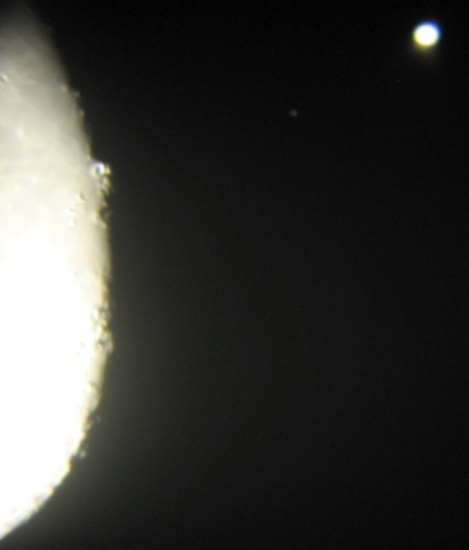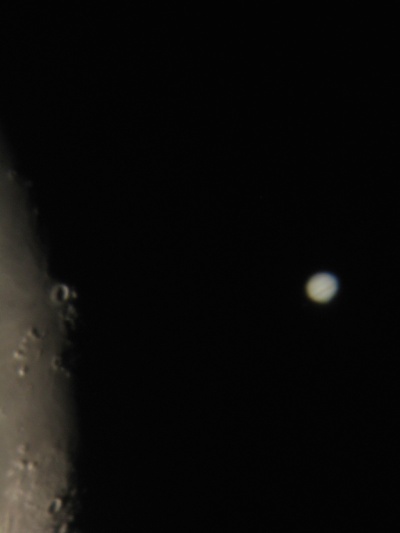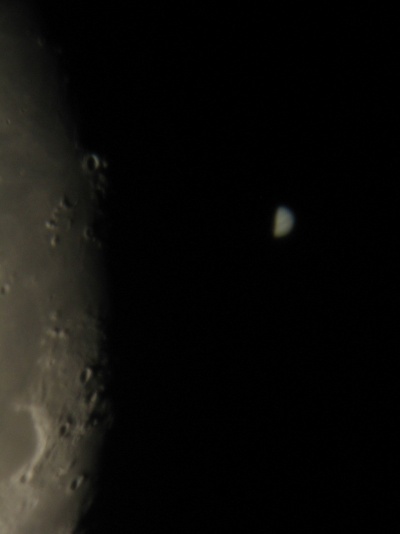|
Jupiter Occultation, 20 May 2005 In total contrast to the mostly cloudy weather we had when Jupiter was brushing past the Moon (as seen from the Cape) a month before, it was totally clear in Wellington on 20 May. Of equal contrast to the excellent seeing we had on 22 April despite the bad conditions, terrible seeing prevailed on 20 May, making it near impossible to take good photographs which was a bit of a disappointment. A few of our OOG (Orion Observation Group) members, gathered at the Wamakersvallei Voortrekker terrain in Wellington to follow this relatively rare event. About a dozen more members of the public joined after an invitation on RSG's Sterre en Planete radio program earlier that evening. To pass the time while the Moon slowly sneaked up on Jupiter, we showed people some of the available pretty objects through the telescope and binoculars. This was received with great interest by the public. |
 as seen with the naked eye, a few hours before the occultation. |
 |
Jupiter's brightest Galilean satellite, Ganymede was the first to disappear behind the Moon, almost 15 minutes before Jupiter. Trying to photograph Galilean moons against the much brighter Moon and Jupiter is not easy to get a good picture without overexposing the brighter objects. The disappearances happened on the dark edge of the moon which was not visible. This uncertainty added to the suspense of waiting for the actual events. |
 |
Watching Ganymede's occultation, I could not help but notice
the distinct difference between the occultation of a star
compared to a Jovian moon - its like an electric light being
switched off against it being turned down using a dimmer switch.
This proves that, compared to the pinpoint image of a star,
Jupiter's moons do have a finite size, even though not directly
visible in a telescope.
Rough timing of Ganymede's disappearance and comparing it to the Sky Guide predictions for Cape Town revealed it being about a minute late for Wellington. This benchmark yielded the times when we could expect the upcoming disappearances and reappearances. |
 |
I then mounted my digital camera (a Canon PowerShot A510) afocally on my 9-inch
Newtonian reflector and adjusted the telescope eyepiece for best
focus. Next was Europa's disappearance which signalled that
Jupiter's is only a minute away, prompting me to start shooting
early. Since I have never seen such an occultation before, I had
no idea how long Jupiter takes to disappear behind the Moon. I
was quite surprised how long it took - I had enough time to fire
off a dozen shots, spaced about 3 - 5 seconds apart, as Jupiter
got "swallowed" by the Moon.
(Click here for an animation of the disapperance - 660kByte) People watching naked eye and with binoculars equally enjoyed seeing the dimmer switch being applied to Jupiter this time. |
| Io's occultation shortly after Jupiter was actually missed in the excitement of the main event and Callisto's was again enjoyed visually through the eyepiece. Callisto, being about one magnitude fainter than Ganymede, was noticeably more difficult to see in the glare of the almost full moon being so close. |
| Unfortunately the seeing deteriorated more and the Moon
started setting behind trees by the time of re-appearance,
spoiling the pictures, but none-the-less an unforgettable
experience for which I was glad I made the effort to observe and
share it with others.
Willie Koorts |
 |
|
© 2007 OOG. Alle regte voorbehou |